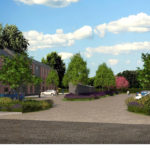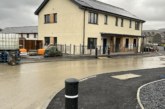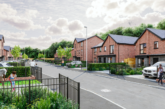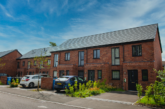Bristol’s commitment to achieving its carbon neutral pledge by 2030 is being realised with the aid of a sustainable housing development, featuring innovative low-carbon heating. Bristol City Council’s 133 homes at Ashton Rise are being built using the high efficiency Sig iHouse solution, and heated by individual Kensa ground source heat pumps connected to a shared ground loop array of boreholes.
The installation would see each home making lifetime carbon savings of 30 tonnes compared to individual gas boilers, whilst also removing all local NOx emissions, ensuring local air quality is not impacted by the choice of heating system.
With completion expected in Spring 2021, works have commenced on site by developer Wilmott Dixon, with the aid of UK ground source heat pump specialists, Kensa Contracting, undertaking the heat pump system installation.
The development is the first of its kind for Bristol City Council which features 40% of homes for social rent, and will see the council building houses for sale on the private market for the first time.
The Bristol Mayor has set out the commitment of building 2,000 new homes — 800 affordable — a year by 2020. Coupled with Bristol’s 2030 net-zero commitment ahead of any other UK city, the Council have taken an innovative approach to reducing the carbon and air pollution from its housing programme early on. Following the Greater London Authority’s findings that Kensa Contracting’s communal ground source heat pump design is the lowest cost solution for end users and the most efficient and lowest carbon heating technology, Bristol City Council is leading the transition away from gas for new build developments by using Kensa’s British-manufactured Shoebox ground source heat pumps in the Ashton Rise development.
Councillor Paul Smith, Cabinet Member for Housing, said: “The work at Ashton Rise brings together two of the council’s top priorities for Bristol — our commitment to build new homes, and to become a carbon neutral city by 2030. As a city, we’re determined to position ourselves as leaders in the housing we build and bring together innovative design and energy efficiency.
“It’s great to have developers and Kensa specialists working closely with the council to deliver this scheme and support our ambitions to build sustainable, thriving communities.”
David Broom, Commercial Director at Kensa Contracting said: “With fossil fuel heating systems being ruled out from new-builds from 2025, Bristol City Council’s commitment to a lower carbon alternative six years ahead of the deadline should be viewed as the new benchmark. Bristol’s plans for net-zero carbon by 2030 are ambitious, yet by adopting the low-carbon and low-cost approach used at Ashton Rise, we wholly expect Bristol to make huge strides to achieving its objective.”

The ground source heat pump system at Ashton Rise has been future-proofed to enable residents to save now and in the future. Due to the stable temperature of the ground all year round, electrically-powered ground source heat pumps offer continuous energy and carbon saving improvements as supporting technology and initiatives advance; the introduction of flexible time-of-use tariffs could enable Ashton Rise residents to enjoy even greater savings, whilst the heating system has been enabled to allow passive cooling from the ground loop, which is naturally cooler than the air in summer, offering virtually free cooling when needed.
Neal Stephens, Managing Director for Willmott Dixon South West said: “This scheme has been designed to help Ashton Rise become a sustainable housing development. By showcasing innovative solutions to carbon waste reduction, we hope to inspire other developers to consider their own carbon footprint and the effect it has on the city. We feel deeply rooted in Bristol, and hope that these innovative developments will not only support the local community, but the local environment too.”
Header image is an artist impression of the Ashton Rise development.









